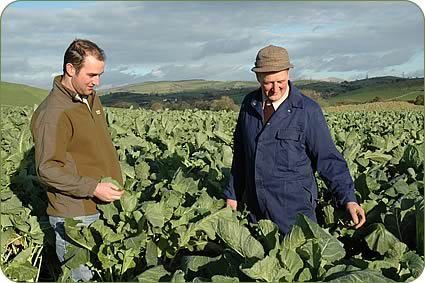Jennifer MacKenzie is an agricultural photo journalist with almost 30 year's experience. Operating from her base in Cumbria, Jennifer undertakes mainly industry-related freelance writing and photography.
Happy cows thrive on kale
Exploiting a small acreage of kale to extend the autumn grazing season by up to a month helps a Cumbrian dairy farming family reduce milk production costs whilst keeping cows happy and healthy.
 |
| Howard and Thomas Nelson with this year's kale crop |
Father and son Thomas and Howard Nelson first grew four acres of kale for their commercial herd of 80 Friesian type milkers in 2004 and they were so pleased with the results that they have put another four acres down to the crop this year.
The Nelson family has been farming at Cockrigg, Halfpenny Lane, Stainton, near Kendal for generations. Thomas and Howard deal with most of the farm's day to day work, Thomas's wife Sheila helps with the calves and his father Bill, who previously ran the farm with his wife Sybil, still lends a hand at the age of 85!
The 200-acre mixed unit's cattle enterprises are self-sufficient with dairy replacements being home-bred by AI. Crossbred heifers sired by their two Limousin stock bulls are retained as replacements for the 20-cow suckler herd, which produces yearling calves for the store market.
A flock of 100 North of England Mule ewes are crossed with the Texel, Suffolk and Charollais, lambing in February aiming for the Easter prime lamb market with all being sold by May or June.
With the exception of contractors being used to sow the kale and make the first cut silage, the farm is reliant on family labour.
"Many years ago we always used to grow kale and keep the cows out until Christmas, but since we started to grow it last year we are the only farm in the area to have a crop now," said Thomas Nelson.
"It's going back to producing milk as cheaply as possible, which we have to do with today's low milk price, but getting the cows out for longer gives them a bit of exercise and helps to keep them healthy," he added.
The Nelsons take two cuts of silage, one to fill the clamp with the second made into big bales. They are using the kale as a break crop in fields that are close to the farm, re-seeding the following year with long-term grass leys, which are down for a minimum of six years.
This year's kale crop followed the first cut silage and it was sown by contractor with an air seeder in mid July. To help minimise poaching of the ground in the autumn, the field was not ploughed, simply disked.
Before sowing, the field had received dressings of slurry and FYM as well as a compound fertiliser 20.10.10 at 2cwt to the acre. The seed had been treated with systemic, seed-applied insecticide, to reduce flea beetle attack.
A dry spell at the time of sowing and no rainfall for two weeks caused the seed to be slow to germinate but once it did it was quick to establish.
Winters are relatively mild and wet at Cockrigg, which lies over 300ft above sea level and is, with the exception of one field, in Less Favoured Area. The Nelsons chose the Maris Kestrel variety of kale for its good leaf-to-stem ratio, as well as its winter hardiness. It's a highly flexible grazing variety bred for intake, digestibility and animal performance.
This autumn's fine weather has extended the grass grazing season at Cockrigg and the cows were turned onto the kale crop on November 14th - two weeks later than last year - with a view to it taking a month to graze off.
Last year's crop was under-sown with turnips and inclement weather forced the dairy cows to be fully housed from the end of November.
However, the beef cows which are able to be outwintered on the farm's relatively dry land were turned onto the kale in February, giving a number of options for feeding the crop.
"It's a simple system to operate and it shortens the winter. We put the cows onto the kale straight after the morning milking and move the electric fence back," said Howard Nelson.
"Last year we moved the fence twice each day to make sure they had cleaned up before giving them more.
"By about the middle of the day they have finished and they come back to the farm where they have access to self-feed silage. Because we are using fields which are closer to the farm, they can come inside when it is wet. It's a flexible crop."
The cows are also fed a concentrate blend in the parlour at a flat rate and they have access to straw. An autumn flush of grass is also zero-grazed after mowing and round baling.
Thomas Nelson said: "We don't feed for high yields and we don't want to push the cows, which in turn means more cost. Our cows average around 6,000 litres.
"Grazing the cows on the kale has made them healthier and happier and both milk yields and quality have held up.
"With pressures in input costs, people are looking at alternative forage feeds and we have also considered possibly zero-grazing or baling and wrapping the kale. Our acreage for growing the crop is limited by the size and stocking of the farm."
The Nelsons have also considered growing other alternative crops such as maize and wholecrop, but they have decided to avoid further capital investment in a second silage clamp.

